Connexin 43 Polyclonal Antibody
- Catalog No.:YT1046
- Applications:WB;IHC;IF;ELISA
- Reactivity:Human;Mouse;Rat
- Target:
- Connexin 43
- Fields:
- >>Gap junction;>>Arrhythmogenic right ventricular cardiomyopathy
- Gene Name:
- GJA1
- Protein Name:
- Gap junction alpha-1 protein
- Human Gene Id:
- 2697
- Human Swiss Prot No:
- P17302
- Mouse Gene Id:
- 14609
- Mouse Swiss Prot No:
- P23242
- Rat Gene Id:
- 24392
- Rat Swiss Prot No:
- P08050
- Immunogen:
- The antiserum was produced against synthesized peptide derived from human Connexin 43. AA range:333-382
- Specificity:
- Connexin 43 Polyclonal Antibody detects endogenous levels of Connexin 43 protein.
- Formulation:
- Liquid in PBS containing 50% glycerol, 0.5% BSA and 0.02% sodium azide.
- Source:
- Polyclonal, Rabbit,IgG
- Dilution:
- WB 1:500 - 1:2000. IHC: 1:100-300 ELISA: 1:20000. IF 1:100-300 Not yet tested in other applications.
- Purification:
- The antibody was affinity-purified from rabbit antiserum by affinity-chromatography using epitope-specific immunogen.
- Concentration:
- 1 mg/ml
- Storage Stability:
- -15°C to -25°C/1 year(Do not lower than -25°C)
- Other Name:
- GJA1;GJAL;Gap junction alpha-1 protein;Connexin-43;Cx43;Gap junction 43 kDa heart protein
- Observed Band(KD):
- 43kD
- Background:
- This gene is a member of the connexin gene family. The encoded protein is a component of gap junctions, which are composed of arrays of intercellular channels that provide a route for the diffusion of low molecular weight materials from cell to cell. The encoded protein is the major protein of gap junctions in the heart that are thought to have a crucial role in the synchronized contraction of the heart and in embryonic development. A related intronless pseudogene has been mapped to chromosome 5. Mutations in this gene have been associated with oculodentodigital dysplasia, autosomal recessive craniometaphyseal dysplasia and heart malformations. [provided by RefSeq, May 2014],
- Function:
- caution:PubMed:11741837 reported 2 mutations (Phe-11 and Ala-24) linked to non-syndromic autosomal recessive deafness (DFNBG). These mutations have subsequently been shown (PubMed:12457340) to involve the pseudogene of connexin-43 located on chromosome 5.,caution:PubMed:7715640 reported a mutation Pro-364 linked to congenital heart diseases. This was later shown (PubMed:8873667) to be an artifact.,disease:Defects in GJA1 are a cause of hypoplastic left heart syndrome (HLHS) [MIM:241550]. HLHS refers to the abnormal development of the left-sided cardiac structures, resulting in obstruction to blood flow from the left ventricular outflow tract. In addition, the syndrome includes underdevelopment of the left ventricle, aorta, and aortic arch, as well as mitral atresia or stenosis.,disease:Defects in GJA1 are the cause of autosomal dominant oculodentodigital dysplasia (ODDD) [MIM:164200]; al
- Subcellular Location:
- Cell membrane ; Multi-pass membrane protein . Cell junction, gap junction . Endoplasmic reticulum . Localizes at the intercalated disk (ICD) in cardiomyocytes and the proper localization at ICD is dependent on TMEM65. .
- Expression:
- Expressed in the heart and fetal cochlea.
Mussel‐Inspired Conductive Cryogel as Cardiac Tissue Patch to Repair Myocardial Infarction by Migration of Conductive Nanoparticles. ADVANCED FUNCTIONAL MATERIALS 2016 Apr 27 WB,IF Rat 1:100 cardiomyocytes
PDGF-mediated PI3K/AKT/β-catenin signaling regulates gap junctions in corpus cavernosum smooth muscle cells. EXPERIMENTAL CELL RESEARCH Exp Cell Res. 2018 Jan;362:252 WB Rat 1:1000 corpus cavernosum smooth muscle cells (CCSMCs)
P6 Electroacupuncture Improved QTc Interval Prolongation by Upregulation of Connexin43 in Droperidol Treated Rats. Evidence-based Complementary and Alternative Medicine Evid-Based Compl Alt. 2014;2014:926423 WB Rat 1 : 1000 ventricle
The use of antibody modified liposomes loaded with AMO-1 to deliver oligonucleotides to ischemic myocardium for arrhythmia therapy. BIOMATERIALS Biomaterials. 2014 Apr;35:3697 IHC Rat 1:100 left ventricle
Gu, Wenqing, et al. "Elevated levels of miR-483-5p in oocytes aggravates premature ovarian insufficiency induced by CDDP by targeting the FKBP4." (2020).
The use of antibody modified liposomes loaded with AMO-1 to deliver oligonucleotides to ischemic myocardium for arrhythmia therapy. BIOMATERIALS Biomaterials. 2014 Apr;35:3697 IHC Rat 1:100 left ventricle
Muscone attenuates susceptibility to ventricular arrhythmia by inhibiting NLRP3 inflammasome activation in rats after myocardial infarction. Yanhong Tang IHC,WB Rat 1:1000,1:1000 hearts
Genotoxicity of bisphenol AF in rats: Detrimental to male reproductive system and probable stronger micronucleus induction potency than BPA. JOURNAL OF APPLIED TOXICOLOGY Jinyao Chen IHC Rat testis
- June 19-2018
- WESTERN IMMUNOBLOTTING PROTOCOL
- June 19-2018
- IMMUNOHISTOCHEMISTRY-PARAFFIN PROTOCOL
- June 19-2018
- IMMUNOFLUORESCENCE PROTOCOL
- September 08-2020
- FLOW-CYTOMEYRT-PROTOCOL
- May 20-2022
- Cell-Based ELISA│解您多样本WB检测之困扰
- July 13-2018
- CELL-BASED-ELISA-PROTOCOL-FOR-ACETYL-PROTEIN
- July 13-2018
- CELL-BASED-ELISA-PROTOCOL-FOR-PHOSPHO-PROTEIN
- July 13-2018
- Antibody-FAQs
- Products Images

- Immunofluorescence analysis of A549. 1,primary Antibody(red) was diluted at 1:200(4°C overnight). 2, Goat Anti Rabbit IgG (H&L) - Alexa Fluor 594 Secondary antibody was diluted at 1:1000(room temperature, 50min).3, Picture B: DAPI(blue) 10min.
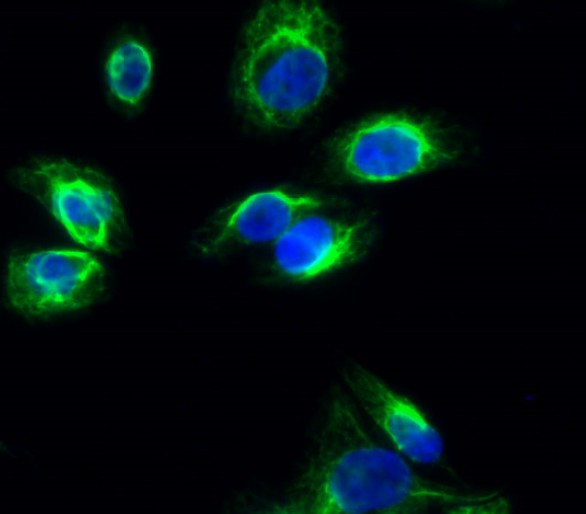
- Immunofluorescence analysis of Hela cell. 1,Connexin 43 Polyclonal Antibody(green) was diluted at 1:200(4° overnight). 2, Goat Anti Rabbit Alexa Fluor 488 Catalog:RS3211 was diluted at 1:1000(room temperature, 50min). 3 DAPI(blue) 10min.

- Immunofluorescence analysis of rat-heart tissue. 1,Connexin 43 Polyclonal Antibody(red) was diluted at 1:200(4°C,overnight). 2, Cy3 labled Secondary antibody was diluted at 1:300(room temperature, 50min).3, Picture B: DAPI(blue) 10min. Picture A:Target. Picture B: DAPI. Picture C: merge of A+B
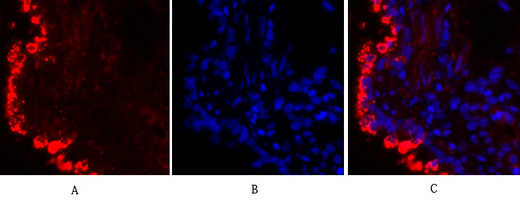
- Immunofluorescence analysis of rat-lung tissue. 1,Connexin 43 Polyclonal Antibody(red) was diluted at 1:200(4°C,overnight). 2, Cy3 labled Secondary antibody was diluted at 1:300(room temperature, 50min).3, Picture B: DAPI(blue) 10min. Picture A:Target. Picture B: DAPI. Picture C: merge of A+B
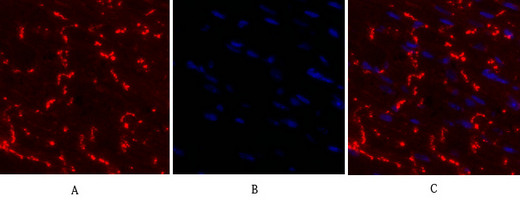
- Immunofluorescence analysis of mouse-heart tissue. 1,Connexin 43 Polyclonal Antibody(red) was diluted at 1:200(4°C,overnight). 2, Cy3 labled Secondary antibody was diluted at 1:300(room temperature, 50min).3, Picture B: DAPI(blue) 10min. Picture A:Target. Picture B: DAPI. Picture C: merge of A+B
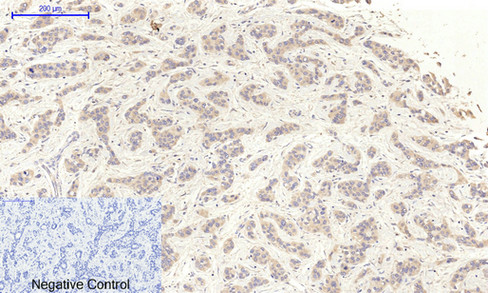
- Immunohistochemical analysis of paraffin-embedded Human-liver-cancer tissue. 1,Connexin 43 Polyclonal Antibody was diluted at 1:200(4°C,overnight). 2, Sodium citrate pH 6.0 was used for antibody retrieval(>98°C,20min). 3,Secondary antibody was diluted at 1:200(room tempeRature, 30min). Negative control was used by secondary antibody only.
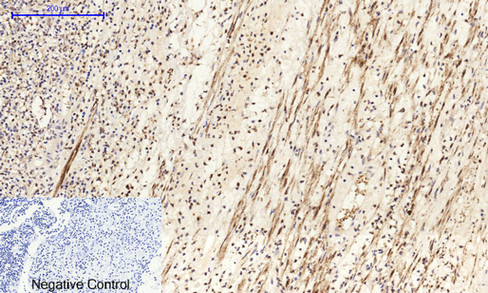
- Immunohistochemical analysis of paraffin-embedded Human-Appendix tissue. 1,Connexin 43 Polyclonal Antibody was diluted at 1:200(4°C,overnight). 2, Sodium citrate pH 6.0 was used for antibody retrieval(>98°C,20min). 3,Secondary antibody was diluted at 1:200(room tempeRature, 30min). Negative control was used by secondary antibody only.

- Immunohistochemical analysis of paraffin-embedded Rat-kidney tissue. 1,Connexin 43 Polyclonal Antibody was diluted at 1:200(4°C,overnight). 2, Sodium citrate pH 6.0 was used for antibody retrieval(>98°C,20min). 3,Secondary antibody was diluted at 1:200(room tempeRature, 30min). Negative control was used by secondary antibody only.
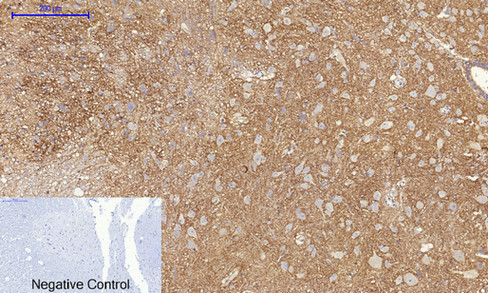
- Immunohistochemical analysis of paraffin-embedded Rat-spinal-cord tissue. 1,Connexin 43 Polyclonal Antibody was diluted at 1:200(4°C,overnight). 2, Sodium citrate pH 6.0 was used for antibody retrieval(>98°C,20min). 3,Secondary antibody was diluted at 1:200(room tempeRature, 30min). Negative control was used by secondary antibody only.

- Immunohistochemical analysis of paraffin-embedded Rat-brain tissue. 1,Connexin 43 Polyclonal Antibody was diluted at 1:200(4°C,overnight). 2, Sodium citrate pH 6.0 was used for antibody retrieval(>98°C,20min). 3,Secondary antibody was diluted at 1:200(room tempeRature, 30min). Negative control was used by secondary antibody only.
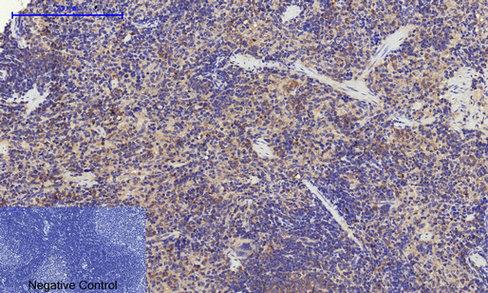
- Immunohistochemical analysis of paraffin-embedded Rat-spleen tissue. 1,Connexin 43 Polyclonal Antibody was diluted at 1:200(4°C,overnight). 2, Sodium citrate pH 6.0 was used for antibody retrieval(>98°C,20min). 3,Secondary antibody was diluted at 1:200(room tempeRature, 30min). Negative control was used by secondary antibody only.

- Immunohistochemical analysis of paraffin-embedded Mouse-liver tissue. 1,Connexin 43 Polyclonal Antibody was diluted at 1:200(4°C,overnight). 2, Sodium citrate pH 6.0 was used for antibody retrieval(>98°C,20min). 3,Secondary antibody was diluted at 1:200(room tempeRature, 30min). Negative control was used by secondary antibody only.

- Immunohistochemical analysis of paraffin-embedded Mouse-kidney tissue. 1,Connexin 43 Polyclonal Antibody was diluted at 1:200(4°C,overnight). 2, Sodium citrate pH 6.0 was used for antibody retrieval(>98°C,20min). 3,Secondary antibody was diluted at 1:200(room tempeRature, 30min). Negative control was used by secondary antibody only.
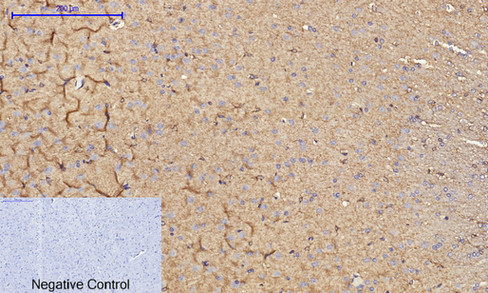
- Immunohistochemical analysis of paraffin-embedded Mouse-brain tissue. 1,Connexin 43 Polyclonal Antibody was diluted at 1:200(4°C,overnight). 2, Sodium citrate pH 6.0 was used for antibody retrieval(>98°C,20min). 3,Secondary antibody was diluted at 1:200(room tempeRature, 30min). Negative control was used by secondary antibody only.
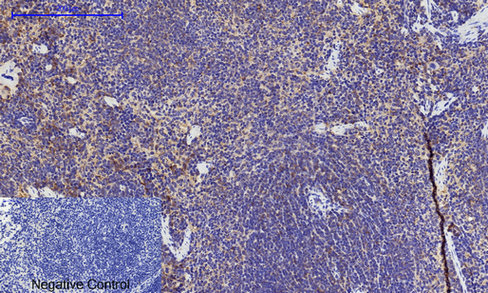
- Immunohistochemical analysis of paraffin-embedded Mouse-spleen tissue. 1,Connexin 43 Polyclonal Antibody was diluted at 1:200(4°C,overnight). 2, Sodium citrate pH 6.0 was used for antibody retrieval(>98°C,20min). 3,Secondary antibody was diluted at 1:200(room tempeRature, 30min). Negative control was used by secondary antibody only.
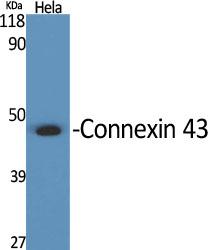
- Western Blot analysis of various cells using Connexin 43 Polyclonal Antibody diluted at 1:2000
.jpg)
- Western Blot analysis of A549 cells using Connexin 43 Polyclonal Antibody diluted at 1:2000
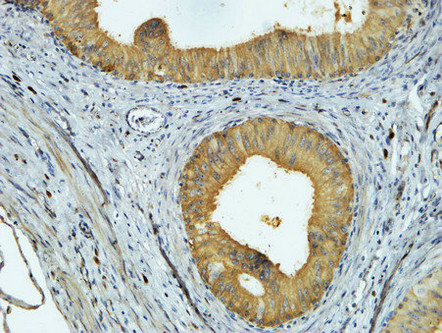
- Immunohistochemical analysis of paraffin-embedded Human colon. 1, Antibody was diluted at 1:200(4° overnight). 2, High-pressure and temperature EDTA, pH8.0 was used for antigen retrieval. 3,Secondary antibody was diluted at 1:200(room temperature, 30min).



